When Do Rhodesian Ridgebacks Go Into Heat?[Timeline]
As a Rhodesian Ridgeback owner, you may be wondering when your precious pup will go into heat. This is a common question for many dog owners, as understanding your furry friend’s reproductive cycle can help you plan and care for her better. While it’s important to recognize that each dog is unique, there are some general guidelines to keep in mind for this breed.
Rhodesian Ridgebacks, like other breeds, typically experience their first heat cycle between 6 and 12 months of age. While this time frame can vary, it’s helpful to know the signs indicating that your dog may be in heat. Keep an eye out for swelling of the vulva, light bleeding, and changes in behavior, such as increased affection and urination.
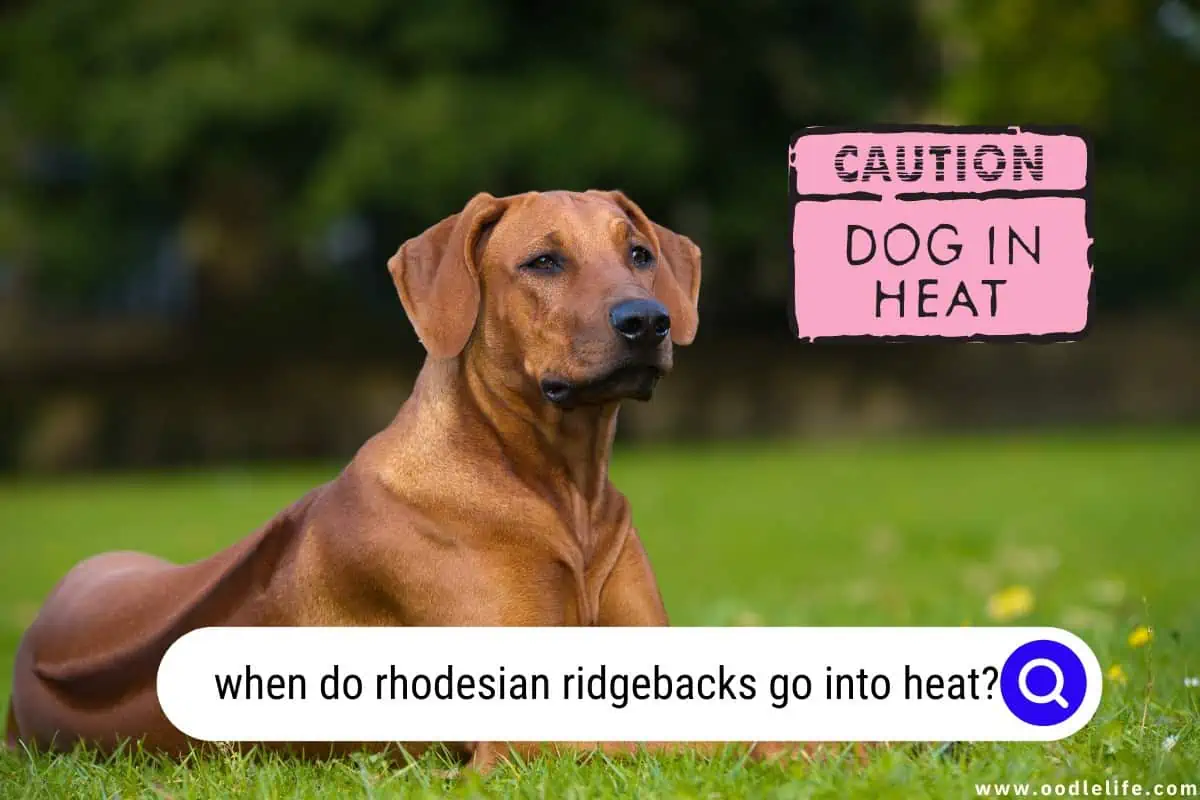
Understanding the nuances of your dog’s heat cycle will ensure she receives proper care during this time and will help you avoid unintentional doggy parenthood.
Of course, our canine companions never fail to keep us on our toes with their unique quirks. So, while you may think you have your Rhodesian Ridgeback’s heat cycle all figured out, it’s entirely possible she’ll have other plans. Grab a comfy seat, and enjoy the journey as you navigate the exciting world of Rhodesian Ridgebacks and their heat cycles.
As you develop a deeper understanding and bond with your dog, you’ll both be better equipped to handle whatever surprises come your way.
Understanding Heat in Rhodesian Ridgebacks
Heat Cycle Basics
Rhodesian Ridgebacks, like other dog breeds, undergo a heat cycle. Female Rhodesian Ridgebacks typically experience their first heat cycle between 6 to 12 months of age. The heat cycle, or estrus period, lasts around 18 to 24 days, but may vary for each individual dog.
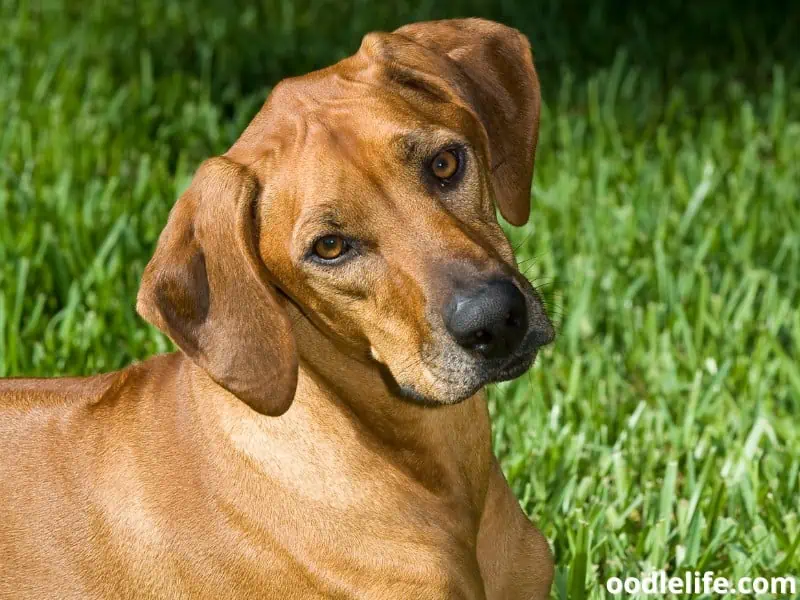
It is important for pet owners to understand this cycle in order to properly manage a female dog’s reproductive health and to avoid unwanted pregnancies.
During the heat cycle, female dogs will show signs like swelling of the vulva and discharge. Male dogs may also become more interested in her and exhibit behaviors such as marking territory and attempts at mounting. This is due to the release of pheromones and hormones from the female dog, which signals that she is in heat and receptive to mating.
Rhodesian Ridgebacks have two heat cycles per year, with a period of anestrus in between. This breed, originally from South Africa, features a unique ridge along their spine, which is caused by the hair growing in the opposite direction to the rest of the coat. This distinctive feature has become one of the key identifiers for the breed, setting them apart from other, similar-looking hounds.
When it comes to breeding, it’s crucial that both the male and female dogs are healthy and well-bred, ensuring that the resulting puppies inherit the desired traits from their parents, such as the iconic ridge. To maintain the health and legacy of this wonderful breed, responsible breeding practices should always be followed.
In summary, understanding the heat cycle in female Rhodesian Ridgebacks is essential for proper care and management of both male and female dogs during this time. By staying informed and attentive, owners can help ensure the well-being of their beloved pets and contribute to the preservation of the Rhodesian Ridgeback breed for future generations.
Signs of a Rhodesian Ridgeback in Heat
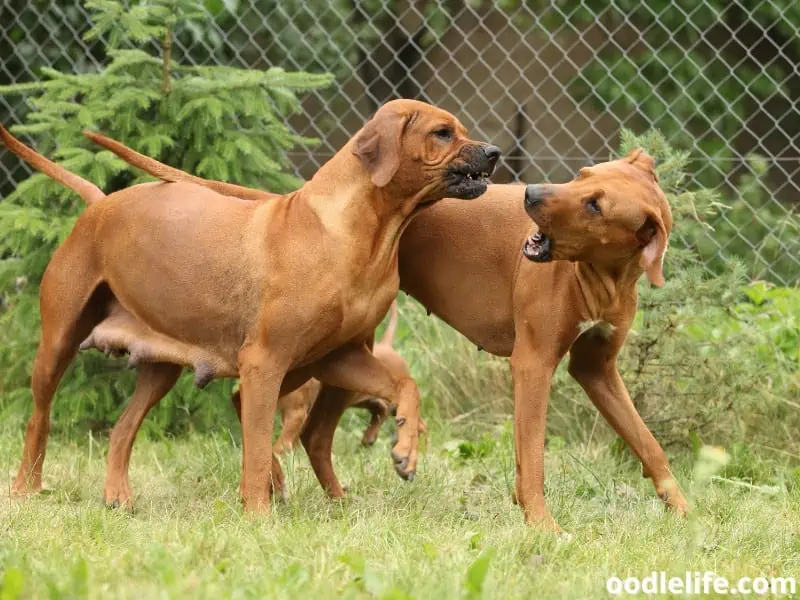
Physical Signs
When your Rhodesian Ridgeback goes into heat, there are some physical signs you can look for to determine if your furry friend is experiencing this change. One of the most noticeable signs would be swollen vulva as well as some vaginal discharge. The discharge is typically reddish-brown in color, also known as bleeding. It may resemble a small drop at the beginning of the cycle but will usually increase as days go by.
It’s important to remember that each dog is different, and the severity of these signs may vary. However, being able to recognize them can help you keep your pup comfortable during this time.
Behavioral Signs
Apart from the physical signs mentioned above, your Rhodesian Ridgeback may also exhibit some noticeable changes in behavior during their heat cycle. One of these behavioral signs could be an increase in aggression. You might find that your otherwise friendly and well-behaved dog is suddenly a little more irritable and assertive, especially towards other dogs.
Excuse them if they seem a bit moody – we all have those days.
Another common behavioral sign is that your dog might become more restless than usual. They may pace around the house, whine or even try to escape. Don’t be surprised if your Rhodesian Ridgeback turns into an escape artist searching for potential mates.
In this case, keep an eye on them and maybe invest in some puzzle toys to keep them occupied.
In conclusion, it’s essential to be aware of both the physical and behavioral signs of your Rhodesian Ridgeback going into heat. It’s a natural phase, so just make sure they’re comfortable and give them some extra love and attention as they navigate through this hormonal roller coaster.
Stages of the Heat Cycle
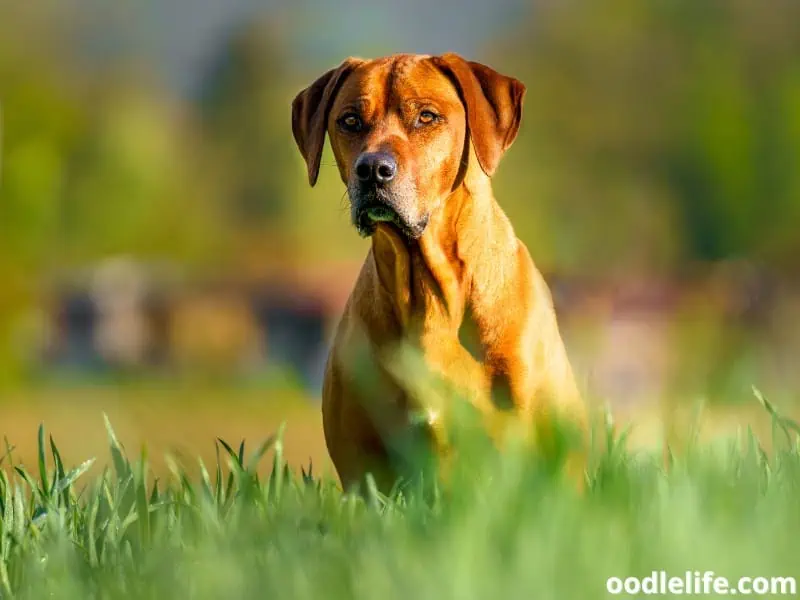
Proestrus
Proestrus is the first stage of a Rhodesian Ridgeback’s heat cycle, typically lasting 7-10 days. During this time, the bitch will start attracting males but won’t be receptive to mating just yet. You may observe some bloody discharge and swelling in her vulva.
It’s essential to keep a watchful eye and make sure she’s comfortable during this period.
Estrus
Next comes the Estrus stage, often referred to as the “fertile” phase, lasting approximately 5-14 days. During this time, the female’s discharge lightens in color, and she becomes receptive to mating. If you’re a breeder, this is the prime time for successful breeding.
For pet owners, ensure your Ridgeback is confined or supervised to prevent unwanted litters. Remember, love may be in the air, but responsible pet ownership is essential!
Diestrus
Diestrus is the third stage, lasting around 60-90 days. By this time, the female’s interest in mating has waned, and her hormone levels gradually decline. If the Rhodesian Ridgeback became pregnant during Estrus, this is the period of gestation.
If not, it’s a pseudo-pregnancy where her body mimics pregnancy, but no puppies are on the way. Be supportive, either way – every lady deserves a little pampering sometimes!
Anestrus
Finally, Anestrus marks the resting phase of the heat cycle, lasting around 4-5 months for Rhodesian Ridgebacks. During this time, her reproductive system goes on a well-deserved vacation. It’s important to use this period to address any health concerns or needed vaccinations, as her hormones are at their lowest levels.
In conclusion, the heat cycle of a Rhodesian Ridgeback consists of four main stages: Proestrus, Estrus, Diestrus, and Anestrus. Each stage brings changes in hormones, behavior, and fertility, making it essential for breeders and pet owners alike to understand and navigate these phases responsibly.
When Rhodesian Ridgebacks Go Into Heat?
First Heat
Rhodesian Ridgebacks typically experience their first heat cycle between 6 and 12 months of age. During this time, you’ll notice physical changes such as swelling of the vulva, and your dog may become more affectionate or restless. Remember that every dog is different, and factors like genetics and overall health can affect the onset of their first heat cycle.
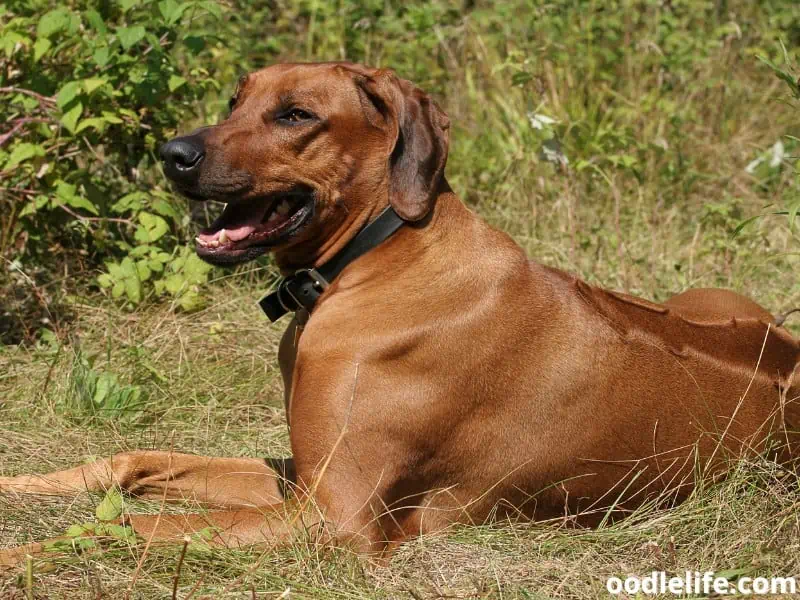
Maturity
Sexual maturity in Rhodesian Ridgebacks is typically reached around 18 months to 2 years of age. However, it’s crucial to note that even though they may be physically capable of breeding, it doesn’t mean they’re emotionally or mentally mature enough for the responsibilities of motherhood. It is generally recommended to wait until a Ridgeback has fully matured, both physically and mentally, before considering breeding.
Frequency
Rhodesian Ridgebacks, like most other breeds, usually go into heat every 6 to 8 months. Again, this may vary depending on individual factors and environmental conditions. It’s essential to keep track of your dog’s heat cycles and watch out for any irregularities or health concerns, and consult with a veterinarian if needed.
In conclusion, Rhodesian Ridgebacks experience their first heat relatively early, with sexual maturity reached at around 18 months to 2 years of age. Each dog is unique, and heat cycles may vary in frequency. Always prioritize your dog’s well-being and consult with a vet for any concerns regarding their reproductive health.
Safety and Care During the Heat Cycle
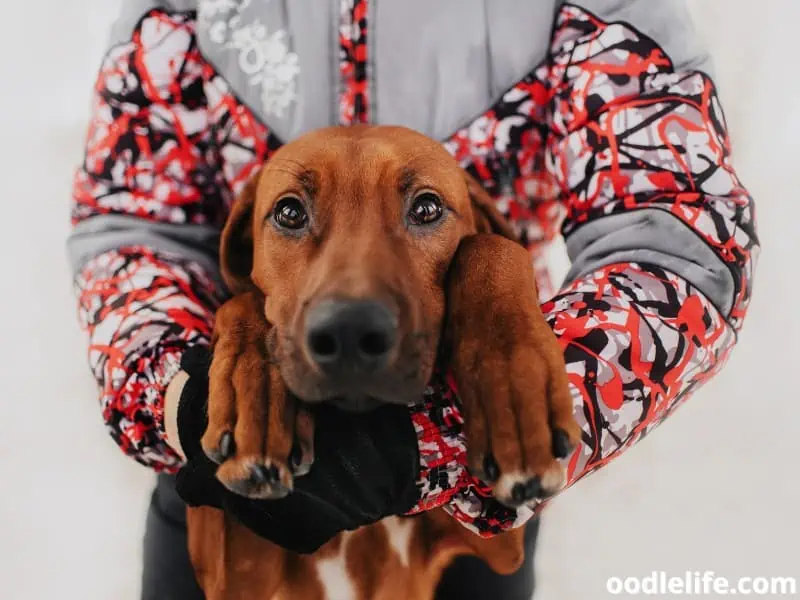
Environment and Exercise
Creating a comfortable and safe environment is crucial during your Rhodesian Ridgeback’s heat cycle. Provide a clean, quiet space with soft bedding to help her feel secure. Use extra layers or absorbent pads to avoid messes caused by discharge.
Exercise is still essential but should be supervised and controlled. Walks should be on a leash to prevent unwanted encounters with other dogs.
Nutrition
During the heat cycle, a Ridgeback may experience changes in appetite. Keep a close eye on her food intake and offer nutritious meals to support her well-being. It’s essential to provide adequate hydration, especially during hot weather.
Consult with a veterinarian for any unique nutritional requirements your dog may need during this time.
Monitoring and Veterinarian Visits
Regularly monitoring your Ridgeback’s behavior, discharge, and overall health during the heat cycle is essential for her safety and care. Keep a record of any changes or symptoms and don’t hesitate to contact your veterinarian for guidance or if you have concerns. Scheduling a check-up before and after the heat cycle can help ensure your dog is healthy and prevent potential complications.
Remember, the key to a stress-free heat cycle for both you and your Rhodesian Ridgeback is maintaining a safe environment, ensuring she receives proper nutrition and exercise, and staying vigilant with monitoring and veterinarian visits. And hey, some extra belly rubs and snuggles won’t hurt either!
Managing Male and Female Interaction
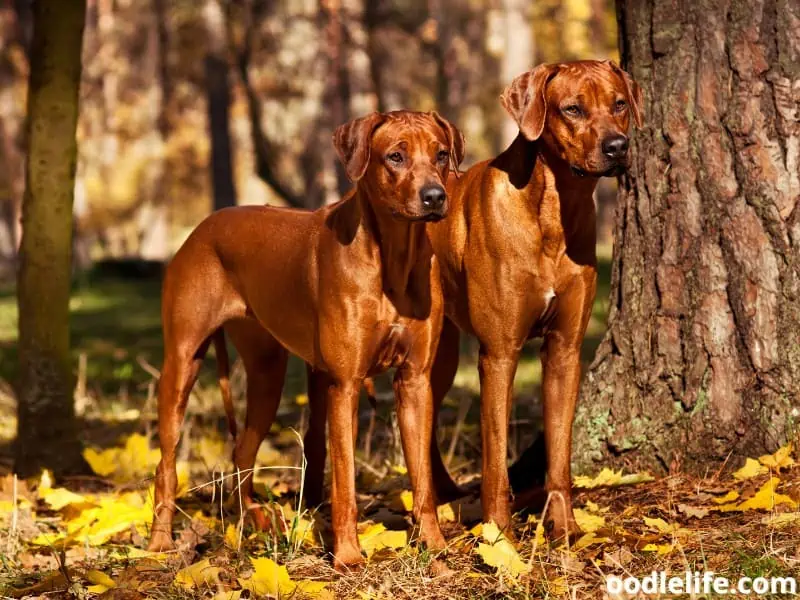
Behavioral Issues and Training
When Rhodesian Ridgebacks go into heat, it’s essential to manage male and female interactions to avoid any potential problems. During this time, female dogs will release pheromones, and male dogs will become more interested in them. This heightened attention can lead to aggression towards other male dogs and general behavioral problems, such as excessive barking or attempts at escaping to pursue the female.
To maintain a harmonious environment, training and obedience are key. Start by providing consistent, positive reinforcement-based training to teach your dogs how to behave appropriately around each other. This will help curb any unwanted aggression or other behavioral issues.
Incorporating activities like structured playtime or walks can also help keep your dogs occupied, reducing the temptation to engage in problematic behavior.
Preventing Unwanted Mating
What’s worse than an awkward doggy date? An unplanned litter of puppies! To prevent unwanted mating, it’s essential to put some physical barriers in place when your Rhodesian Ridgeback goes into heat.
One effective method is to separate the male and female dogs by keeping them in separate rooms or using baby gates to create designated areas for each dog. Keep a close eye on them during this time and never leave them unsupervised together.
Aside from physical barriers, you can also explore options such as spaying or neutering your dogs. This not only helps to prevent unwanted breeding but can also reduce the likelihood of certain health issues and hormonal-driven behaviors. Remember, when it comes to managing male and female interactions, a little bit of planning and forethought can go a long way in maintaining a happy and harmonious home!
Breeding Rhodesian Ridgebacks
When it comes to breeding Rhodesian Ridgebacks, there are a few important factors to consider for the overall health and well-being of the dogs involved. This section will discuss pregnancy and whelping, as well as genetic considerations that should be taken into account.
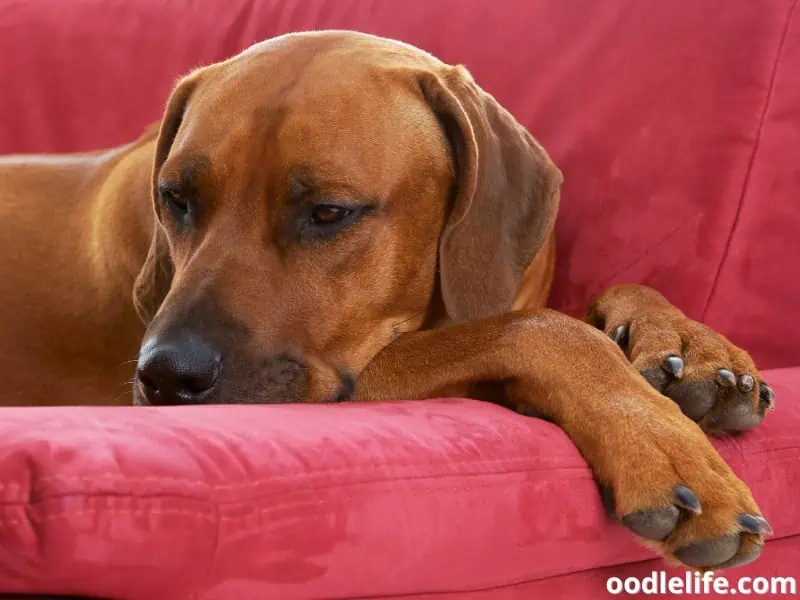
Pregnancy and Whelping
Rhodesian Ridgebacks, like other breeds, typically go into heat every 6 months. Female dogs can experience their first heat cycle as early as 6-12 months of age, but responsible breeders often wait until the dog is fully mature (around 2 years) before considering breeding.
During the pregnancy, a Rhodesian Ridgeback female will carry her puppies for approximately 63 days. Ensuring that the pregnant dog receives proper nutrition and veterinary care is crucial for a successful and healthy litter. Frequent check-ups with a veterinarian can help monitor the pregnancy and prepare for any potential complications.
Whelping, or the process of giving birth, can be an anxious time for breeders and their dogs. It’s important to provide a comfortable, safe, and quiet space for the mother to give birth. Rhodesian Ridgebacks can have an average litter size of 8-12 puppies, so be prepared for a sizeable new pack of little ones!
Genetic Considerations
Before breeding any Rhodesian Ridgeback, it’s essential to assess their genetic health to prevent the passing of unwanted traits or conditions. One common genetic ailment in this breed is hip dysplasia, a malformation of the hip joint which can lead to arthritis and decreased mobility.
Fortunately, hip dysplasia can be screened for by having a qualified veterinarian perform evaluations and x-rays. By ensuring that both the mother and father have healthy hip joints, the likelihood of puppies inheriting this condition can be minimized.
Another genetic consideration is the potential for early onset adult deafness (EOAD). It has been linked to an in-frame deletion in the EPS8L2 gene. By conducting genetic testing before breeding, you can reduce the risk of passing on this trait to the puppies.
In conclusion, breeding Rhodesian Ridgebacks should involve thorough planning, attention to genetic health, and proper care for both mother and puppies. Responsible breeders can work together to maintain the breed’s integrity while ensuring the health and well-being of these splendid dogs.
Spaying and Health Benefits
Spaying your Rhodesian Ridgeback comes with a variety of health benefits. This procedure not only regulates their heat cycles but also helps prevent certain health problems down the line. Let’s explore some of these benefits without getting too clinical or lengthy.
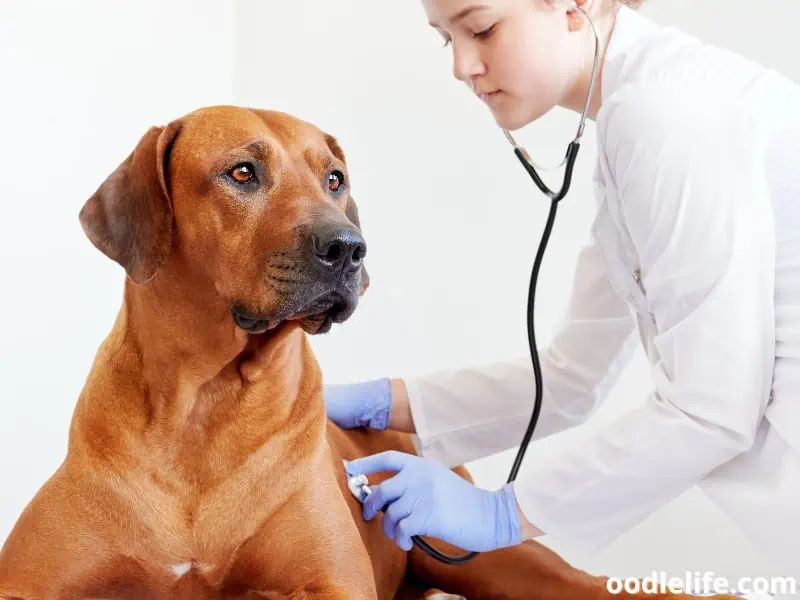
First things first, spaying can help prevent your female Ridgeback from going into heat, which usually happens around five months of age. With no heat cycle, you can rest easy knowing that your dog won’t be attracting suitors in the neighborhood. Also, you get to avoid that dreaded cleanup duty around her vulva, which can be quite a chore during her heat cycles.
Think of this as a small favor that keeps on giving!
As your Rhodesian Ridgeback reaches mental maturity, spaying offers more than just a break from heat cycles. It reduces the risk of common health problems like mammary tumors, pyometra—a severe infection of the uterus—and other reproductive disorders. Spaying not only helps your beloved fur child stay healthier but also potentially extends her lifespan.
Additionally, spaying can help manage some urination-related issues. In some cases, spaying can help reduce urinary incontinence or other urination problems associated with hormonal imbalances in female dogs. Plus, you don’t have to worry about her marking her territory on your expensive Persian rug!
So, when you think about spaying your Rhodesian Ridgeback, remember the healthy and happy life you’re helping her live. Not only will you be avoiding messy heat cycles, but you’ll also be contributing to her long-term health, physical comfort, and overall well-being. It’s a win-win situation for both you and your furry companion!
Just think about it; you can use all that saved time and energy to chase after something else, like crows in the park…you know, typical dog stuff.
Rhodesian Ridgeback Background
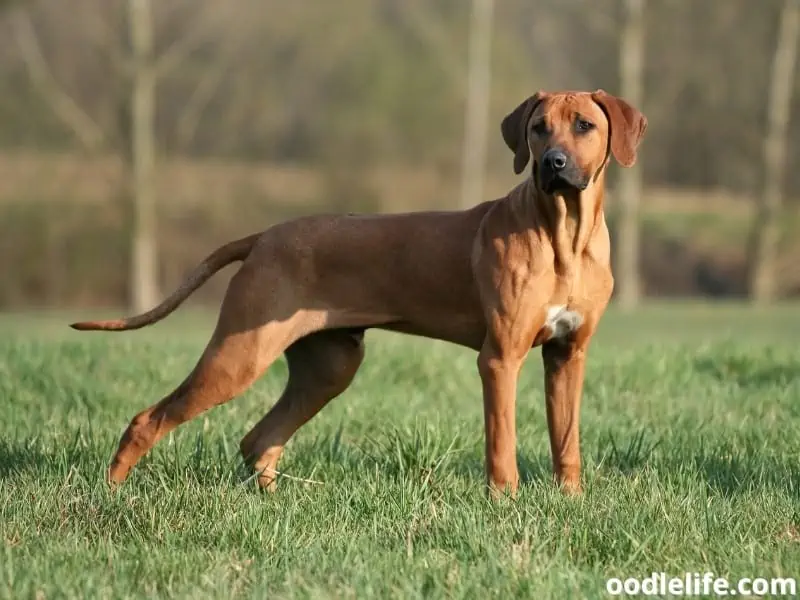
Historical Origins
The Rhodesian Ridgeback has its roots in Africa, where it was bred for its hunting prowess. These energetic and loyal dogs have a unique appearance with a ridge of hair growing in the opposite direction along their spine. This distinctive feature is what gives them their name.
The breed was developed by crossing native African dogs with European breeds, resulting in a tough and versatile hunter.
Function and Role in Africa
In Africa, Rhodesian Ridgebacks played a vital role as hunters, protectors, and companions. Their small size and agile physique made them excellent at tracking lions, earning them the nickname “African Lion Dogs.” Their incredible energy and stamina allowed them to keep up with the fast-paced hunting environment.
These dogs were not only used for hunting lions but also served as guides and protectors for their human companions. Their loyalty and bravery were highly valued, making them an integral part of African life.
Hunting
The Rhodesian Ridgeback was built for the rigorous task of hunting in the African wilderness. Their strong sense of smell and keen eyesight made them excellent trackers, able to pick up a scent and follow it for miles. Their relatively small size and height allowed them to maneuver easily in the dense undergrowth and rocky terrain often encountered while hunting.
Loyalty and Appearance
One of the most endearing qualities of the Rhodesian Ridgeback is its unwavering loyalty. These dogs form strong bonds with their human families, making them great companions on African hunting expeditions and at home.
Their unique appearance adds to their appeal, with their muscular build and distinctive ridge of hair running down their backs. This breed is the epitome of strength and grace, making them a popular choice for dog lovers searching for the perfect blend of form and function.
Conclusion
Rhodesian Ridgebacks, like other dog breeds, experience heat cycles. There is no strict timetable for when they will go into heat, but owners can generally expect this to occur once or twice a year. Being prepared and knowledgeable about this natural process will make it easier to handle and ensure the well-being of your beloved pet.
In general, female Rhodesian Ridgebacks begin to experience heat cycles around 6-12 months of age, though this can vary. Taking note of any changes in behavior, such as increased affection or restlessness, can help you identify when your dog is going into heat. Additionally, physical signs like swelling or discharge can serve as indicators.
It’s essential for Ridgeback owners to monitor their dogs during this time to prevent unwanted breeding and the potential health complications it may entail. To minimize stress, provide your dog with a comfortable and reassuring environment. Implementing a regular exercise routine will also help keep your Ridgeback happy and healthy during this time.
In conclusion, understanding your Rhodesian Ridgeback’s heat cycles and being attentive to their needs during this time significantly contributes to their overall well-being. With proper care, you’ll be well-equipped to support your dog through this natural process, ensuring a stress-free experience for both of you.